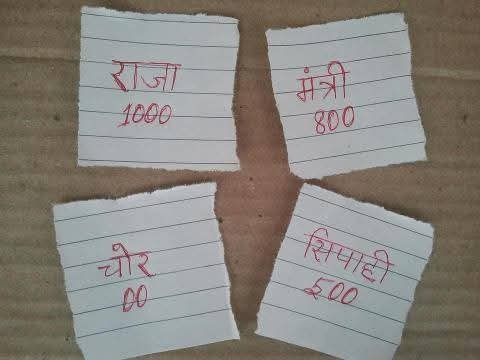Raja Mantri Chor Sipahi / Ram Laxman Seeta Devi
Introduction
The seated version of Raja Mantri Chor Sipahi, where players use paper chits to assign roles rather than running around. This is a simpler, strategic version of the game that is often played indoors or in a more relaxed setting.

Objective
This version of “Raja, Mantri, Chor, Sipahi” is a fun variation of the classic Indian role-playing game. Players are assigned roles and points based on guessing and bluffing.
The objective of the game is to figure out who the Chor (thief).
What You Need
- Paper Chits: Small pieces of paper, each containing a role written on it. You can prepare chits with the following roles:
Raja (King)
Mantri (Minister)
Chor (Thief)
1 or more Sipahi (depending on the number of players)
Fold the chits so that no one can see what’s written on them.
- Players: At least 4 players, but the game is more fun with a larger group (6-10 players).
- A Seated Arrangement: Players sit in a circle or around a table.
- Distribute the Chits:
Shuffle the chits and each player picks one chit randomly from the pile.
Players do not reveal their roles to anyone else.
Points allocation
Raja (King): 1000 points
Mantri (Minister): 800 points
Chor (Thief): – 0 point
Sipahi (Soldier): 500 points
Gameplay Instructions
- Role Assignment:
- Raja’s Turn:
The Raja reveals his role to everyone. The Raja then calls upon the Mantri to identify the Chor from the remaining two players.
- Mantri’s Guess:
The Mantri declares their guess, pointing to the player they believe is the Chor.
- Reveal:
All players reveal their roles after Mantri’s guess.
Scoring:
Raja: Always gets 1000 points.
Mantri:
Correctly identifies the Chor: 800 points.
Wrong guess: 0 points.
Chor:
If not identified: – 500 points.
If identified: -0 points.
Sipahi:
Always 500 points on identifying chor
Rotation:
After each round, the roles are shuffled and redistributed so that everyone gets a chance to play different roles.
Winning the Game
Play a set number of rounds (e.g., 5 or 10 rounds).
Add up the points at the end. The player with the highest total score wins the game.
This seated version adds a strategic layer to the game as players try to bluff or deduce the roles based on behavior.
- The Game Begins:
The game is usually played in silence or with quiet conversation. The Raja can ask the players questions or give commands to test who might be the Chor, but the Chor will try to remain undetected.
The Sipahi are tasked with identifying and “catching” the Chor, but they do not know who the Chor is yet.
The Mantri is often a neutral player, though they may try to help the Raja.
- The Secret Actions:
At any point in the game, the Chor can secretly make a move to “steal” or do something that will indicate they are the Chor, like making a slight movement or gesture that others should not notice.
Sipahi must keep an eye on all players, trying to figure out who the Chor is based on subtle clues or interactions.
- The Investigation:
The Raja can point to a player and ask if they are the Chor, while the Sipahi may try to also identify the Chor by looking for suspicious behavior.
The Chor can try to mislead the group with good acting or subtle gestures.
5.Winning the Game:
If the Sipahi catch the Chor, the Sipahi win.
If the Chor remains undetected or completes their objective, the Chor wins.
You can play multiple rounds and switch roles to ensure everyone gets a chance to play as different characters.
Game Variations
- MultipleSipahi : If there are more than 6-7 players, you can have more than one Sipahi in the game. This adds complexity, as only one of the sipahi will get chance to identify chor.
Skills Developed
Observation: Players must pay close attention to subtle movements and interactions.
Acting: The Chor must be good at blending in and avoiding suspicion.
Critical Thinking: Players must deduce who the Chor is based on limited information.
Cultural Significance
Raja Mantri Chor Sipahi has been played across generations and regions in India as a fun social game. It often serves as an icebreaker during social gatherings or festive occasions.
The game is a way of introducing roles like Raja, Mantri, Chor, and Sipahi (king, minister, thief, and policeman) symbolically, representing authority, protection, and mischief.
Address
Bharatiya Khel
Indian Knowledge Systems (IKS) Division
Ministry of Education (MoE),
Government of India,
Our office is located in
All India Council for Technical Education (AICTE)
Nelson Mandela Marg,
Vasant Kunj,
New Delhi-110070

